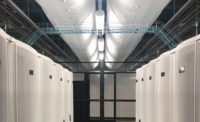In January, the open fields of Harvard, Illinois — a far northwestern suburb of Chicago — are biting and bone-chilling. Inside Kirk Cashmore’s barn, it is a fair 72°F, the perfect temperature for producing leafy heads of lettuce through vertical hydroponics — the practice of water-based gardening with vertically stacked shelving in a controlled environment.
Since 2011, Cashmore has been the only for-profit vertical hydroponic farmer in Northern Illinois. His pesticide- and chemical-free lettuce is served at Duke’s Alehouse and Kitchen, a popular, Green-certified restaurant in nearby Crystal Lake. It's also sold at biweekly basket drops along the North Shore and in the Madison, Wisconsin, metro area.
“Working for my grandfather as a big-acre farmer for many years taught me how things worked," Cashmore said. "I always knew I wanted to be a farmer, but I wanted to take a different approach to it. I didn't have the capital or the money to buy big acres to start a traditional farm, so I went around the Midwest and looked at farms that were growing hydroponically and figured out how to start my own.”
A GROWING INDUSTRY
According to a recent report, the vertical farming market is estimated to be valued at $5.8 billion by 2022, growing at a compound annual growth rate of 24.8 percent between 2016 and 2022.
Factors driving growth of the vertical farming market include generating high-quality food without the use of pesticides, less dependency on the weather for production, a growing urban population, an increase in the year-round production of crops, and reduced impact on the environment.
“The beauty of hydroponic farming is there really is no downtime … I have assets throughout the whole winter and am the only game in town when it comes to winter production of lettuce, Swiss chard, kale, and all the small greens that can be harvested hydroponically,” Cashmore said.
None of his yield is ever wasted. Unsold (yet still edible) greens are donated to a local food pantry, and wilted or damaged heads are sent to the compost bin.
Inside Cashmore’s 3,500-square-foot building, three vertically stacked shelves built from recycled materials provide room for up to 4,000 heads of lettuce. Each shelf grows approximately 1,200 heads, or about five heads per square foot, which Cashmore reports is the number to beat in the world of vertical hydroponics. With room in his barn to still expand out- and upwards, Cashmore has the potential to harvest nearly 8,000 heads.
Plants are seeded in rockwool, a lava-like medium that allows for more oxygen than soil or water, and an ebb and flow pumping system supplies water to the roots. Cashmore checks pH levels daily.
Winter in the Midwest means long periods of grey, cloudy skies. An electronic timer ensures lights remain on based on the amount of sun — typically 16 hours a day, seven days a week. Relying on the timer to turn lights on and off as needed gives Cashmore — a one-man show — the freedom to tend to other business without worrying.
“Timers are very important for turning lights and fans on and off,” Cashmore said. “Having an electronic timer makes this an automated sport, so I can have more time with my family and friends. It gives me more time to not have to work.”
He also believes that ensuring a good supply of oxygen is absolutely vital to growing success. Floating rafts of lettuce — or any system where roots are permanently soaked in water — offer little available oxygen, since the solubility of oxygen in water is remarkable low. Cashmore monitors how much oxygen his roots have and uses an ozone system to kill bacteria, control oxygenation, and keep the water sanitized. This has eliminated the need to use chemicals like chlorine or hydrogen peroxide.
“I find that if something is worth doing, it's worth doing right," Cashmore said. "As a father of three little girls, I have no tolerance for chemicals going home and into my kids’ mouths. I want to make the best produce that I can for my family, my clients, and my friends.”
ORGANICALLY GROWN PRODUCE
One of the biggest benefits of hydroponic farming is the superb quality of the produce. Plants don’t spend any time outside in the wind, dirt, or rain, and they grow in a controlled environment that is bug-, chemical-, and pesticide free. This creates greens with unmatched body and texture. As more and more people buy organic and seek out locally grown produce, demand is certain to grow. Cashmore envisions remaining profitable and productive by adding more capacity to double or triple the lettuce headcount along with growing a variety of other vegetables in the winter.
“From school field trips to other farmers and private citizens, there’s an increasingly large interest in my hydroponics facility. I hope to see more vertical hydroponic farms popping up in the area over the next decade.”
This article was supplied by Intermatic. For more information, visit www.intermatic.com.
Publication date: 4/22/2019
Want more HVAC industry news and information? Join The NEWS on Facebook, Twitter, and LinkedIn today!






